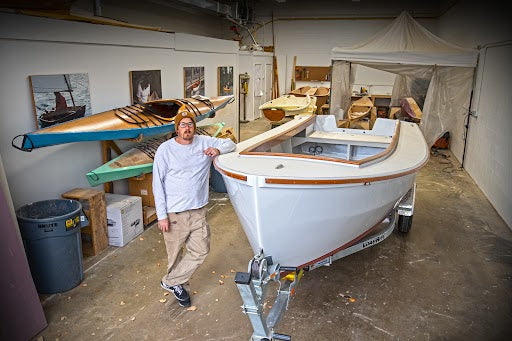Specifications
Performance
Stability
Speed
Cockpit Room
Payload
Ease of Construction

Overview
We've completed on-water testing of the prototype Gislinge Boat replica and we're delighted with its performance. The boat is a joy to sail, with surprising stability and the acceleration of a racing dinghy.
Our fealty to an authentic hull shape, combined with modern wood-epoxy composite construction, results in a boat that looks, and—especially—feels, like a Late Viking Age working craft. Yet she's a practical choice for ordinary folks to build, use, and maintain.
Is your reenactment group looking for a Gislinge Boat that can be built quickly and is light enough to tow with an SUV? Would your organization be interested in building a boat with our guidance at CLC's classroom in Annapolis?
With the goals of our Gislinge project met, we have decided to part with our demo model. It has always been stored inside—and we need the room. Not currently on a trailer, but we can include a trailer at additional expense. The boat includes the rig and custom-made oars, and is "turnkey," ready to raid. The price is $29,995. Please email info@clcboats.com if you are interested.

The Story Behind our Gislinge Boat Replica
In 1993, archeologists excavated a boat near the village of Gislinge (GISS-ling-ah), in Denmark. Dendrochronology established that the boat was built around the year 1130. Apparently, the boat saw hard use fishing and hauling cargo before being abandoned in a marsh about 50 years later.
In 2015, the Viking Ship Museum in Roskilde, Denmark reconstructed the Gislinge Boat and released the working drawings to the public, launching the Gislinge Boat Open Source Project.
At an overall length of 25'4", John Harris and the team at CLC thought that a replica Gislinge Boat was small enough to be an accessible amateur boatbuilding project. But not if they stuck with the 12th-century original's split-oak planks and iron rivets!
In 2019, Chesapeake Light Craft began developing a computer-cut wood-epoxy replica of the Gislinge Boat. Eschewing the traditional materials and techniques that were used by the 12th-century Danes, CLC's pre-cut marine plywood kit is assembled using modern and simple "stitch-and-glue" techniques. By updating the tools and methods, CLC has made the construction of this ancient design accessible to serious amateur builders and organizations. The structural epoxy coating will ensure durability and minimize upkeep. (Fiberglass cloth is used sparingly in CLC's replica, only in high-wear spots.) The discreet addition of built-in positive buoyancy will make it much easier to recover from a swamping.
The structural "apron" around the cockpit perimeter at the thwart level conceals the foam buoyancy, and the switch from a square sail to a dipping lug are the only obvious deviations from the look and feel of the 900-year-old original. The dipping lug is a lighter and simpler rig. John Harris remarks: "Handling a boat like this, with the side-slung rudder and all, already involves a lot of new stuff that none of us have done before. I don't like to get involved with trying too many new things at once. A dipping lug looks right on the boat—only the serious academic types will even notice that it's a different rig—and it's only three strings to pull on instead of five or six. It's also a great upwind sail...because all sailing on the Chesapeake is upwind.
CLC designer Jay Hockenberry was responsible for the CAD/CAM engineering and has been the project-manager of this ambitious undertaking. In January 2020 we built a 33% scale model of the Gislinge Boat to test the assembly sequence.

Preserving the essential, elemental beauty of the Gislinge Boat's lines without making the thing impossible to build, took months of study, iteration, and mock-ups. "Screwing up the lines of this boat was just unthinkable," says Harris. "Other than taking some 'stealers' out of the planking line-off, we could overlay our lines and the lines of the museum original. (Stealers are a planking feature that is neither necessary or desirable in stitch-and-glue construction.) Though this modern take on the design is built from stitched-and-glued marine plywood, but this boat will have both the look AND feel of the 12th-century original."
COVID spoiled plans to assemble Hull #1 in a boatbuilding class during the summer of 2020. Instead, the CLC staff in Annapolis began assembly of the full-sized stitch-and-glue Gislinge Boat in November 2020, masks clamped over faces.
We've now enjoyed several years of on-water testing, and the first kit has been shipped, completed by amateur builders, and launched.
Many thanks the folks at the Viking Ship Museum in Roskilde, Denmark,for their technical support, feedback, and enthusiasm.
Main Gallery
Construction Gallery
Line Drawings
Videos
Frequently Asked Questions
We Can Help You Build This Boat
We offer classes for many of the boats we sell. For boats, such as this one, we can offer private classes upon request. Some customers also ask us to build the boat for them.
View Classes
Need Help Building it?
We’re here to help with any questions you might have during the build process.




















































